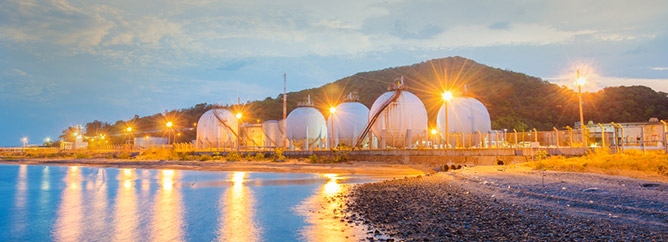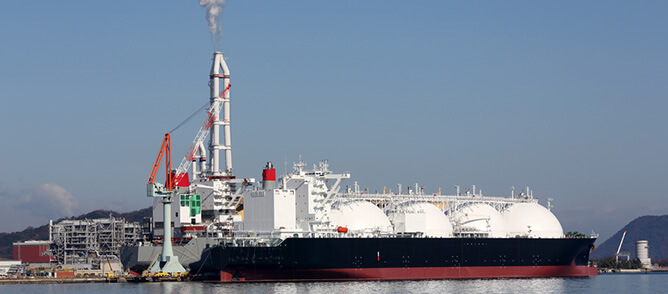
LNG Safety Concerns – How to Purge LNG Tanks
Liquefied natural gas (LNG) is one of the most useful forms of natural gas in use today for both domestic and industrial use. Cryogenically chilled and liquefied natural gas is typically composed of methane and smaller proportions of other hydrocarbon compounds.
This gaseous mixture has the advantage of being able to save valuable storage space due to its reduced volume when compared to non-compressed natural gas. While this fuel is relatively safe to store, transport, and handle, there are still misconceptions about how hazardous the liquid is.
In this article, we will consider various properties of LNG and discuss how to safely store this vital fuel source.
What Is LNG?
Liquefied natural gas (LNG) is natural gas that has been subjected to sub-zero temperatures at which point it condenses into a liquid state. An LNG fraction can be produced by super-cooling natural gas to very low temperatures at which the newly formed liquid occupies barely 1/600th of its volume in a gaseous state.
LNG is a very stable compound that can be stored indefinitely at ambient environmental temperatures but vaporizes quickly and completely when spilled on any external surfaces leaving no traces behind. Also, LNG is non-toxic and when combined, these properties make fire and other safety hazards unlikely in incidents of accidental spillage.
At What Temperature Does Natural Gas Liquefy
For natural gas liquefaction to occur, the gas must be cooled to -260°F. At this temperature, the gas changes state to a liquid while contracting to a volume about 600 times smaller than its gaseous state.
How Is LNG Transported?
LNG is usually stored and transported in specially designed tanks. For maritime transportation, manufacturers employ large LNG container ships to move the product across vast distances.
These sea-going vessels possess multi-walled designs that separate the tanks and their contents from the hull of the ships. An approximate of 8 feet between them, minimize the chances of an onboard disaster occurring during transport. A similar tank structure is utilized for transport over land and is built to strict specifications with double-walled chambers with inbuilt pressure relief systems
LNG Risks and Safety Concerns
For decades, the LNG manufacturing industry has been safely transporting the fuel in large quantities. However, as with all industrial processes that involve the use of potentially combustible materials, there have been some notable accidents in the past.
For example, during WWII in Cleveland, Ohio, a poorly constructed containment tank failed and leaked into nearby sewers in a residential area. The released vapor subsequently ignited killing over 100 persons and injuring about 200. Although incidences like the one mentioned above have become a rarity due to strict enforcement of storage, and transport standards, the potential LNG hazards remain the same.

Potential Hazards Associated with LNG Spills
The most common LNG spillage risks include:
- Vapor ignition in the presence of a suitable source
- Boiling liquid expanding vapor explosions (BLEVE) due to rapid vaporization
- following LNG container failure
- Rapid phase transition where large volumes of spilled LNG explode without combusting
- Fires from tank ruptures during transport
- Cryogenic burns from direct contact with skin
- Methane asphyxiation
Is LNG Flammable?
The major component of LNG is methane which is a relatively stable chemical compound that is not readily combustible. In its liquefied form, natural gas is not flammable however it will form a vapor cloud if spilled which will ignite under the right conditions.
LNG Spills in Water
Liquefied natural gas does not react when it encounters water. If LNG is accidentally spilled into a water body, it will rapidly vaporize leaving no traces behind. As a result, there is no concern of harm to aquatic life whether plant or animal.
LNG Spills on Ground
When LNG is spilled on a ground surface, it behaves similarly as with water. The fuel will quickly form vapor and dissipate harmlessly and completely as long as an ignition source is not brought into contact with its vapor which is flammable.
Cleaning LNG Tanks for Improved Safety
Even though LNG is considered quite safe, care must be taken while handling it to ensure an even higher safety outcome. Empty LNG tanks or partially full LNG tanks can be purged by passing an inert gas through their interiors to eliminate substances that increase the chances of combustion.
Nitrogen gas is an ideal candidate for LNG tank purging due to its inert, non-combustible properties. Once properly purged, LNG can be safely transported in vessels with minimal risk of accidental combustion.
To conduct nitrogen purging more efficiently in LNG tanks, the use of a dedicated on-site nitrogen gas generator is highly recommended
NiGen Has Nitrogen Purging Solutions for LNG Tanks
At NiGen, we offer a broad range of turnkey industrial air solutions to clients in the energy sector. Among the various solutions, we offer to players in the oil and gas industry, are top-notch nitrogen generators, pipeline maintenance, and pipeline cleaning services designed to handle all your process air needs.
For more information about our trusted nitrogen generation solutions, please contact us today!
